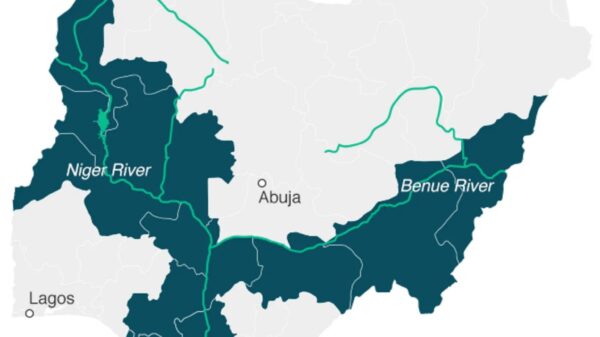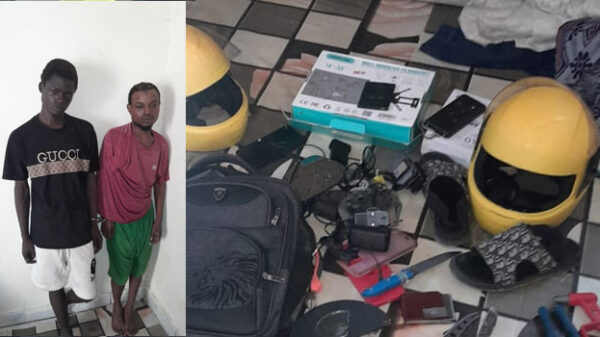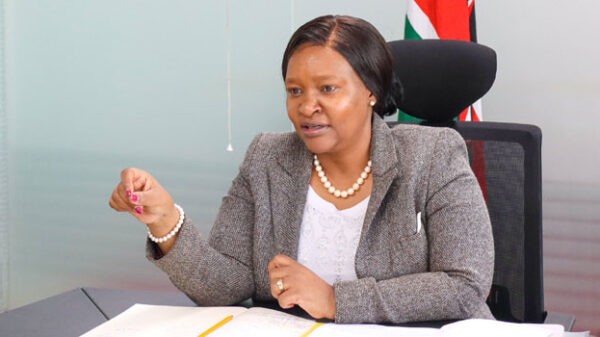KISII, Kenya, Sep 21 – In Kisii town market, 55-year-old Mary Nyaboke is busy cutting her kales (Sukuma wiki) as she waits for customers to come and buy from her.
Nyaboke hopes to pocket at least Ksh.500 per day to help her make ends meet for her daily needs.
Bearing the scorching sun, Nyaboke seems to be in deep thoughts, she wipes thin sweat from her face using a piece of cloth as she silently does her work in the stall.
She narrates, with the high cost of living, life has been difficult on her side as she struggles to feed her five children being a single parent.
She is only able to provide a cup of black tea for each of the children in the morning and a light meal for supper.
Previously, Nyaboke could provide tea, porridge and snacks for breakfast, get them either rice, beans, bananas and some fruits for lunch and a heavy dinner in the evening and shops for a one-month household commodities.
Prices of commodities shot up, this forced her to start buying in small portions to help her cater for family needs, “I am forced to buy a quarter kg of rice, sugar, maize flour and a quarter a liter of cooking oil at least this would last for two to three a week,” says Nyaboke.
High cost of living is majorly driven by Russia’s inversion to Ukraine, which has dramatically worsened the outlook of food prices.
Climate change has also led to land degradation, thus putting agriculture and food production into a crisis.
“Two years ago, my family was comfortable spending at least three thousand shillings in a month, shopping for basics such as food, water, cooking gas, and paying electricity bills,” Nyaboke narrated.
Being the chair-lady of their weekly contributions of merry go round savings group, she took into grievances of her members, straining to make ends meet as they often asked for loans.
She called all the 30 members for a meeting where they had an agenda of finding solutions to coping with the high cost of living within their means.
Previously they would contribute Sh1000 shillings weekly from each member and give out the total amount to two members every Sunday, which would help them improve their business and the lives of their families.
Quick solution.
Members agreed to turn their savings group to pull half of their contributions and use them to purchase food and household commodities in bulk and then divide amongst a group of five members.
They agreed on purchasing essential commodities such as sugar, cooking oil, salt, maize flour, milk, cooking gas, washing soap, rice, beans, tomatoes, and tea leaves to cut off individual costs.
“In May this year, we sat and agreed that instead of giving money to our members, we should use the money to purchase food-stuffs and household commodities and share among the members,” says Nyaboke.
So far, the group has donated food-stuff and household commodities to 15 members.
Jemimah Moraa, a member, says she benefited from this group, and the food she got could sustain her and the family for three months.
“Since I received the food-stuff and household commodities I am now able to make some savings of the profit.
I would have used to purchase food on a daily basis,” said Moraa.
Phanice Gechemba, a fisher trader in Kisii, says she joined a merry-go-round in her workplace, which had 20 members to purposely buy food-stuffs and distribute to members as a way of coping with the high cost of living.
She noted they did not collect money to purchase commodities; here, members would buy anything they could afford, collect and give to members per week as they recorded data of items from each member who could do it in return.
Challenges experienced during contribution
For Nyaboke’s merry-go-round saving group, one out of 15 members who had received the food stuff relocated and never sent her contribution when reached out.
“Members are experiencing slowness in giving out their contributions.” We are supposed to give Sh500 every Sunday to our treasurer while other people go up to Monday, which delays the time of purchasing food and household commodities for its members. some never sent her contribution when she reached out” she narrated.
Inflation cycle drive
James Kenani, an economist, says big companies in Kenya are making a large profit by charging high prices for commodities, and the consumers bear the burden.
The country is facing the inflation cycle with high commodity prices for the consumers paying more than the cost of manufacturing.
This affects the quality of life with fewer resources and inflated costs burdening the consumers. Also, fuel is heavily taxed, a major source of the high cost of living.
The wage bill remains constant as prices go up, and sometimes people are forced to take less, this is difficult to break the inflation cycle, in which, if the need must be, the central bank must come in and break it through lending rates.
Giving funding and skills to women groups
Kisii County Woman Representative Doris Aburi says her office will work with women groups to support them with resources and skills to boost their businesses.
“My office will ensure women groups have got enough funds and managerial skills to boost their businesses, for this will make life easy for them to invest and add stock to their businesses,” said Donya.
She asked women to form more groups for funding and invest in saccos to uplift their livelihoods.
She encouraged the women to register their groups with the National government affirmative action fund kits such as the youth enterprise fund, and the uwezo fund to help them boost their businesses.
Ann Bosibori, a retailer, says they were caught off-guard by the shooting of commodities from the manufacturers and they were also forced to increase the prices for them to remain in the market.
Impact of High cost of living on health
Increased food prices may threaten public health especially disadvantaged groups such as women, children and elderly from low-income countries.
Economic factors resulting from high cost of living may influence a person’s nutrition status and health.
Dr.Bosire says an increase in food prices results in change of diet patterns, and this will cause a severe impact on health and nutrition on people.
“Those people who change their diet patterns because of economic strains may develop nutrition-related diseases such as malnutrition for children under six years,” said Dr.Bosire.
Impact of High cost of production for manufacturers
The Association of Kenya Animal Feed Manufacturers (AKEFEMA), whose primary goal is to act as a self-regulating body in the feeding milling industry, says the average price of raw materials has gone up to 60 percent.
Speaking during a science café, AKEFEMA secretary General Dr.Martin Kinoti noted with the outbreak of COVID19, the price of grain and graining milling by-products such as wheat, pollard, wheat bran,, and Maize bran increased, due to a decrease of production globally.
“We are facing reduced volume availability of the international market and this has worsened the local regulatory environment in the sourcing countries and this exposed most counties in East and Central Africa to an extremely high demand of animal raw materials leading to high prices,” said Dr.Kinoti.
“We are experiencing an all-time drop in the number of commercial firms, and this has resulted in loss of regional competitiveness of Kenyan livestock sector,” said the secretary general.
As the world grapples with a record-breaking inflation cycle, many people in African Countries are extremely weary of unusual double digits inflation numbers in the continent, raising the high cost of living.
The Central Bank of Kenya (CBK) asserts the annual inflation rate increased to 8.3% in July 2022, the highest reading since 2017.
CBK further indicates, Food prices such as Maize, white rice, carrots and beans and non-alcoholic drinks recorded 15.3 percent with an upward pressure while transport price was at 7percent while housing and utilities were at 5.6 percent. The Kenya National Bureau of Statistics (KNBS) indicates the Consumer Price Inflation (CPI) in Kenya, increased a seasonally-adjusted 0.67% to 6.45% in July over the previous month June at 0.89%. as focus economic consensus panelists expect inflation to average 7.1% in 2022..
According to the Famine Early Warning System Network (FEWSN), about 3.5 million people are on the brink of severe hunger even as prices of the scarcely available food rise drastically.
In Kenya, Infection Prevention Control (IPC Acute), Food Insecurity Analysis and Acute Malnutrition Analysis (July 2021-January 2022 issued in September 2021 indicates that 2.1million population in arid and semi-arid areas experienced high levels of food insecurity between July and October 2021.
The report further indicates the majority of these populations facing acute malnutrition are pastoralists in Baringo,Isiolo, Marsabit, Tana River, Garissa, Mandera and Wajir.
Government promises to cushion the cost of the high living burden
It currently costs at least Sh3,000 to refill a 13-kilogramme cylinder of Liquefied Petroleum Gas (LPG).
Kenyan Government has promised to introduce new regulations on the pricing of cooking gas by June next year.
This will be done by introducing an open tender system (OTS) for the importation of cooking gas with the lowest bidder to ship this commodity.
The government is preparing for regulations of cooking gas prices by building a state build terminal to fasten offloading ( LPG).
Kenya’s President William Ruto said his government will invest heavily in agriculture to allow farmers to produce more food.
Ruto said his government will lower fertilizer prices to help farmers plant crops during these short rains.
“My government will work with county government administrators in the next one to two months to reduce the cost of seedlings and fertilizers as part of the plan to elaborate the plan of reducing the cost of living in the country,” said William Ruto.
Nyaboke is optimistic, with President Ruto’s government that things will change and the cost of living will go down and she will be able to provide a comfortable living for her family.
“President Ruto’s promises to lower fertilizer prices will help farmers produce more food and lower prices in the market,” says Nyaboke.

























































